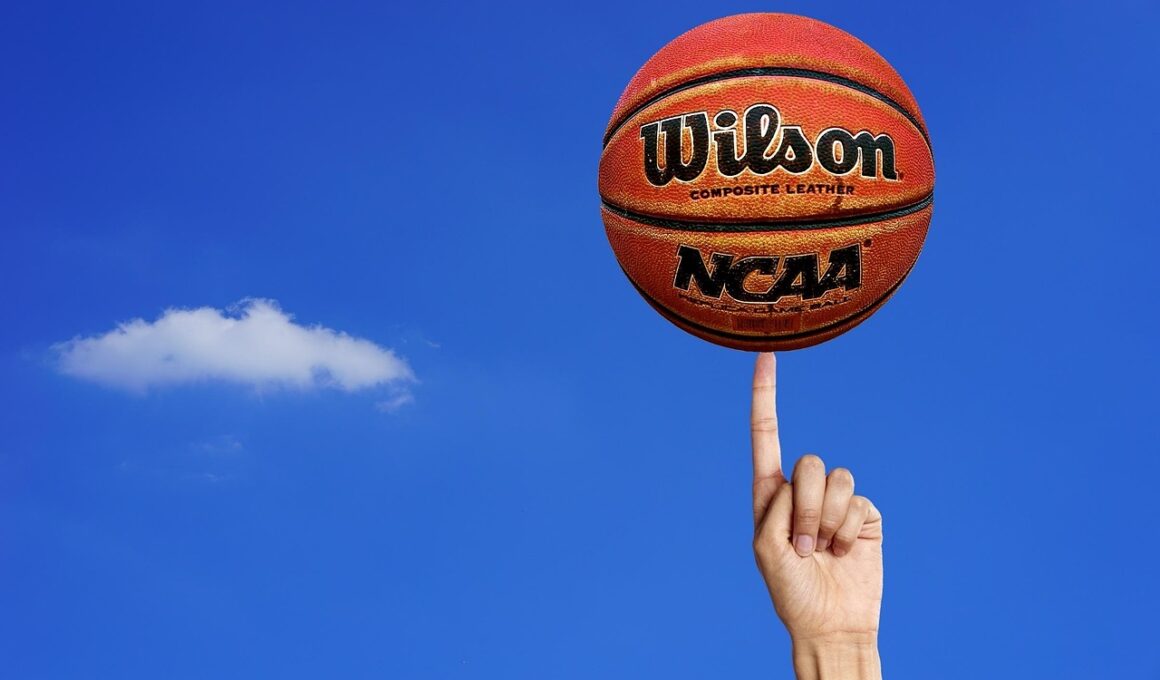Building Finger Strength for Better Ball Control
Finger strength is a pivotal aspect of basketball that often goes overlooked. Players tend to focus on shooting, dribbling, or conditioning, but the ability to control the ball starts with the fingers. Strong fingers contribute to better ball handling, which can elevate a player’s game significantly. Finger exercises tailored for athletes can help develop the musculature needed for enhancing grip and dexterity. Exercising your fingers can be integrated seamlessly into your training routine. Not only does this improve ball control, but it also reduces the risk of injuries during gameplay. A solid grip ensures that you can handle high-speed passes and perform in fast-paced game situations. Engaging in focused training sessions that emphasize finger strength will pay off during match situations. Incorporating these exercises helps in building a stronger foundation for basketball skills overall. Furthermore, improved finger strength translates to better shooting accuracy and dribbling finesse. Explore exercises like finger push-ups and resistance band stretches to build that essential strength. So, dedicate time to this often-ignored skill and notice the changes in your game in no time.
As you delve deeper into finger strength training, consider integrating tools designed specifically for athletes. Tools like grip trainers, hand grippers, or even a simple stress ball can be beneficial. These devices focus on building both strength and endurance in your fingers and hands, enabling better overall control of the basketball. Set aside a specific time during your training regimen to incorporate these activities. Focus varies from player to player; some may need more work on dribbling control, while others might benefit from improved passing techniques. Perform exercises that target each individual finger. Warm-up your hands and fingers before engaging in any intensive practices. For comprehensive workouts, perform 3-4 sets of each exercise with sufficient rest. Consistency will lead to noticeable improvements in a matter of weeks. Track your progress, as keeping a training log can effectively motivate you as you observe developments firsthand. Additionally, don’t overlook the role that nutrition plays in muscle recovery and overall performance. Consuming protein-rich foods aids in muscle repair and growth. Prioritize your finger games just like you’d prioritize leg workouts.
Exercises for Developing Finger Strength
To effectively build finger strength, consider various exercises that can be performed conveniently. One great exercise is the finger push-up, where you balance your weight on your fingertips while performing conventional push-ups. This requires immense strength and helps in improving grip. Another beneficial exercise is the finger stretching technique, achieved by simply spreading your fingers apart and holding them in that position for some seconds. The resistance band workout is another method; wrap bands around your fingers and open them against the band’s tension. Each of these drills focuses on different finger muscles, so combine them for balanced strength. Aim to gradually increase your repetitions as your strength grows. You might also find it useful to practice ball handling drills using only your fingertips. This unique method reinforces the need to focus on finger strength while working on your dribbling and ball control. In addition, use weighted basketballs occasionally to challenge your fingers further. With persistent training, you will witness improvements not just in finger strength but also in overall ball handling. Being patient with yourself during this process will prove invaluable as your skills develop.
Progressing in your training means recognizing your limits and working just beyond them. While developing finger strength, be cautious of not over-exerting your fingers. Gradual increase is key; begin with light resistance and minimal repetitions, then steadily build on that foundation. Incorporate rest days to allow your muscles to recover properly, as fatigue can lead to potential injuries and diminish your progress. Pay close attention to your body’s signals, ensuring you are not pushing past your capacity. Simulating game situations during practice can also provide valuable insights into how strong your finger grip truly is. By integrating training into actual gameplay, you can evaluate and adjust based on real-time experiences. Pairing these practice sessions with feedback from coaches can guide improvements significantly. As your finger strength builds, extend the challenge by varying dribbling techniques and introducing resistance elements, such as dribbling uphill or through tough conditions. This ensures you are gaining skill under pressure. Moreover, always remember to keep your fundamental skills sharp; the development of finger strength should enhance your gameplay rather than overshadow basic principles.
Integrating Finger Strength Training into Your Practice
Integrating finger strength training into your overall practice schedule is essential for sustained improvement. Every practice session can be an opportunity to address finger strength. You can start with specific finger exercises as a warm-up before diving into your main basketball activities. Using the first 10-15 minutes to focus solely on finger exercises can dramatically impact your overall game. Following this warm-up, transition into traditional skill drills like shooting and passing, equipped with stronger fingers. Always maintain the mindset that finger strength will enhance your ball handling and shooting. Use friendly competitions, such as timed dribbling challenges, to emphasize quick finger movements while keeping the training aspect engaging. Incorporate drills that require both speed and control, challenging your newly developed finger strength. Consider setting measurable goals for improvement; for example, aim to increase your grip strength by a predetermined percentage over a few weeks. These goals can be tracked and re-evaluated. Additionally, discussing these matters with your coach can open up opportunities for collaborative development on your finger training routines.
In conclusion, building finger strength is a crucial yet often underrated aspect for basketball players who aspire to improve their ball handling skills. Prioritize this training, as it requires patience and dedication, but the rewards in performance can be great. Your focus on finger exercises will lead to improved control in handling fast-paced situations, ensuring you can perform under pressure. Various drills and tools introduced throughout this article are avenues to effectively integrate finger strength training into your basketball routine. The combination of strength, skill, and proper nutrition cannot be understated. Diet plays a significant role in not only muscle recovery but also delivering energy to push through those demanding sessions. Continue to explore new finger exercises that may benefit you; the range of training available is vast. Ensure that you’re experimenting regularly with different approaches to find what works best for you. Consider involving teammates in your training regimen. This collaboration enhances motivation and offers shared feedback on performance. Empowering your finger strength is a journey that promises rewards, sharpening your overall basketball strategy. Remember, consistent practice leads to lasting improvements.
Final Thoughts on Finger Strength Training
By now, it should be clear that finger strength is key to elevating your overall performance on the court. Consistently working on these skills forms a solid foundation that enhances your basketball abilities in pivotal game situations. Watching how your grip and ball handling evolve over time will be an invigorating experience. Focus not only on technique but also on increasing functional strength, which benefits various other basketball skills. Accept that improvements take time; make a commitment to your training and approach it with the right mindset. Educate yourself on common techniques but always look out for innovative ways to challenge your fingers. Set personal goals and achieve them step by step. Document your milestones as keeping track helps identify areas that need attention. Collaborate with your coach and peers to inspire further improvement; having feedback can reaffirm your technique. Utilize your off-season wisely to reinforce these essential skills. Take care of your overall health and give equal importance to rest and nutrition for full-body performance enhancement. Together, these strategies will serve to optimize your finger strength and bolster your basketball game.


